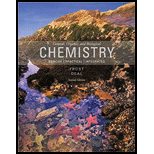
Concept explainers
a.
To determine:
The
Introduction:
Proteins are organic molecules that are made up of amino acids. Amino acid sequences determine the protein structures and its function. The amino acid consists of amino group and carboxyl group along with the hydrogen atom and functional group (designated by R).
b.
To determine:
The metabolic substrate that can be produced from the carbon atoms of isoleucine.
Introduction:
Proteins are organic molecules that are made up of amino acids. Amino acid sequences determine the protein structures and its function. The amino acid consists of amino group and carboxyl group along with the hydrogen atom and functional group (designated by R).
c.
To determine:
The metabolic substrate that can be produced from the carbon atoms of methionine.
Introduction:
Proteins are organic molecules that are made up of amino acids. Amino acid sequences determine the protein structures and its function. The amino acid consists of amino group and carboxyl group along with the hydrogen atom and functional group (designated by R).
d.
To determine:
The metabolic substrate that can be produced from the carbon atoms of phenylalanine.
Introduction:
Proteins are organic molecules that are made up of amino acids. Amino acid sequences determine the protein structures and its function. The amino acid consists of amino group and carboxyl group along with the hydrogen atom and functional group (designated by R).
Want to see the full answer?
Check out a sample textbook solution
Chapter 12 Solutions
MasteringChemistry with Pearson eText -- ValuePack Access Card -- for General, Organic, and Biological Chemistry
 ChemistryChemistryISBN:9781305957404Author:Steven S. Zumdahl, Susan A. Zumdahl, Donald J. DeCostePublisher:Cengage Learning
ChemistryChemistryISBN:9781305957404Author:Steven S. Zumdahl, Susan A. Zumdahl, Donald J. DeCostePublisher:Cengage Learning ChemistryChemistryISBN:9781259911156Author:Raymond Chang Dr., Jason Overby ProfessorPublisher:McGraw-Hill Education
ChemistryChemistryISBN:9781259911156Author:Raymond Chang Dr., Jason Overby ProfessorPublisher:McGraw-Hill Education Principles of Instrumental AnalysisChemistryISBN:9781305577213Author:Douglas A. Skoog, F. James Holler, Stanley R. CrouchPublisher:Cengage Learning
Principles of Instrumental AnalysisChemistryISBN:9781305577213Author:Douglas A. Skoog, F. James Holler, Stanley R. CrouchPublisher:Cengage Learning Organic ChemistryChemistryISBN:9780078021558Author:Janice Gorzynski Smith Dr.Publisher:McGraw-Hill Education
Organic ChemistryChemistryISBN:9780078021558Author:Janice Gorzynski Smith Dr.Publisher:McGraw-Hill Education Chemistry: Principles and ReactionsChemistryISBN:9781305079373Author:William L. Masterton, Cecile N. HurleyPublisher:Cengage Learning
Chemistry: Principles and ReactionsChemistryISBN:9781305079373Author:William L. Masterton, Cecile N. HurleyPublisher:Cengage Learning Elementary Principles of Chemical Processes, Bind...ChemistryISBN:9781118431221Author:Richard M. Felder, Ronald W. Rousseau, Lisa G. BullardPublisher:WILEY
Elementary Principles of Chemical Processes, Bind...ChemistryISBN:9781118431221Author:Richard M. Felder, Ronald W. Rousseau, Lisa G. BullardPublisher:WILEY





